人教版2023年中考英语二轮复习第八课时动词的分类课件
文档属性
| 名称 | 人教版2023年中考英语二轮复习第八课时动词的分类课件 |  | |
| 格式 | pptx | ||
| 文件大小 | 515.3KB | ||
| 资源类型 | 教案 | ||
| 版本资源 | 人教新目标(Go for it)版 | ||
| 科目 | 英语 | ||
| 更新时间 | 2023-05-26 08:47:47 | ||
图片预览


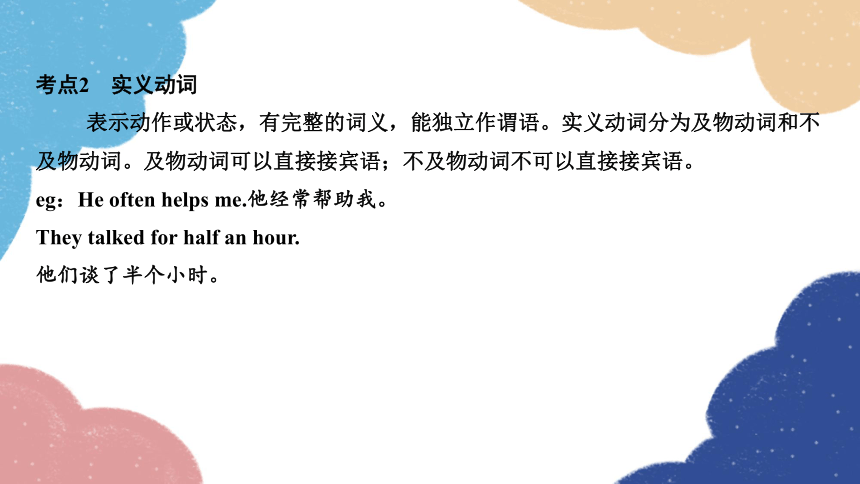
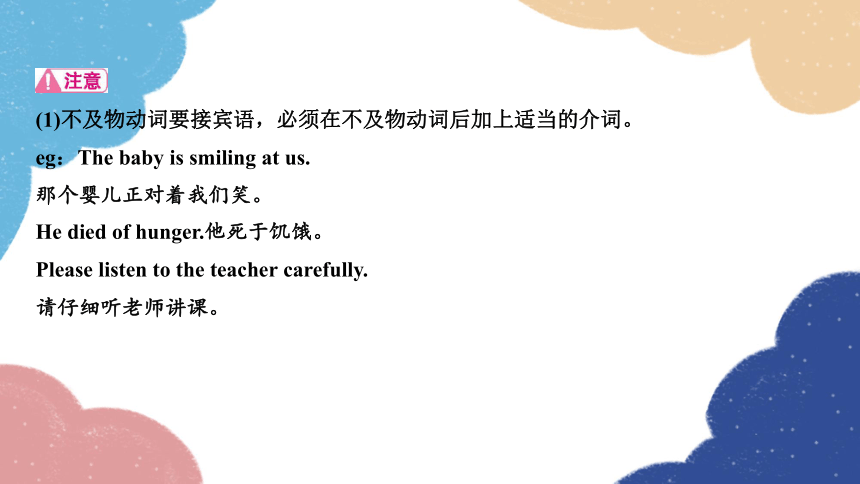

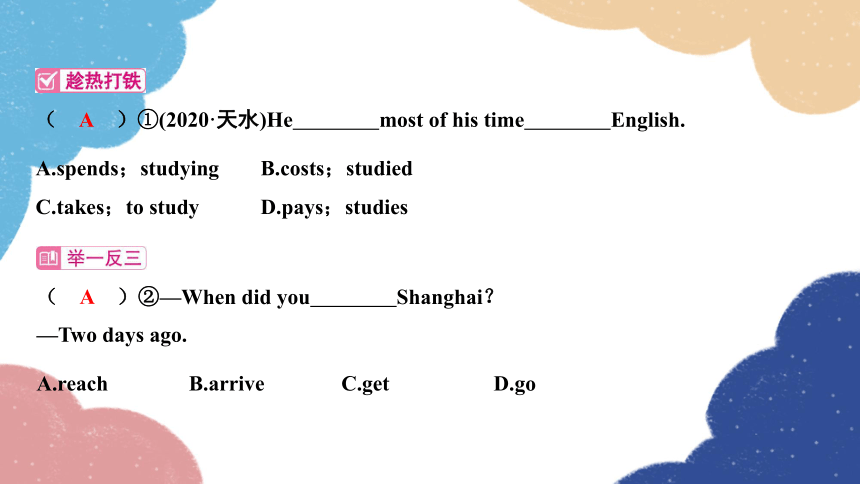
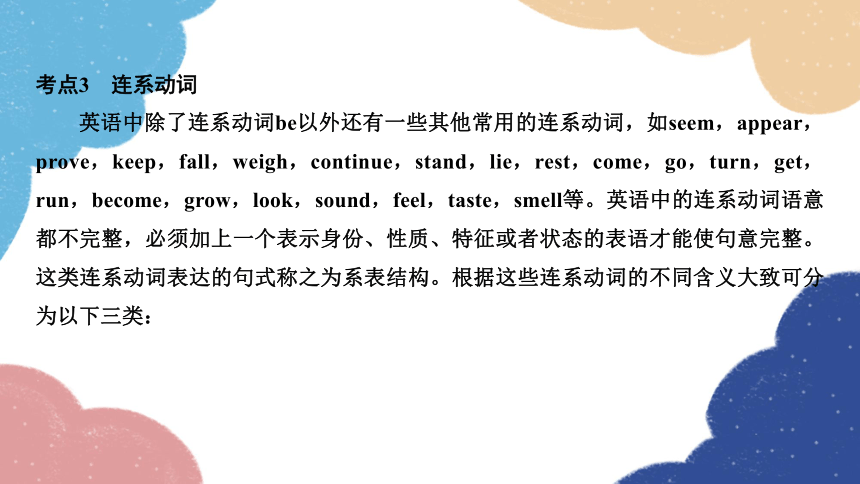
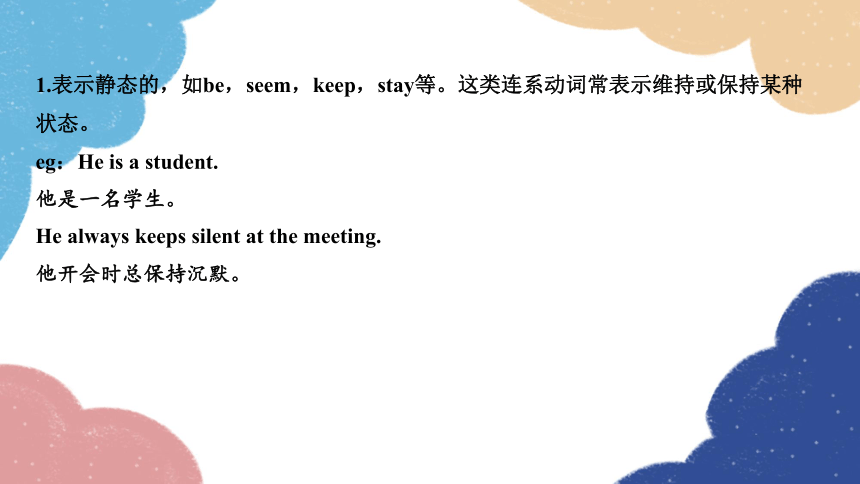

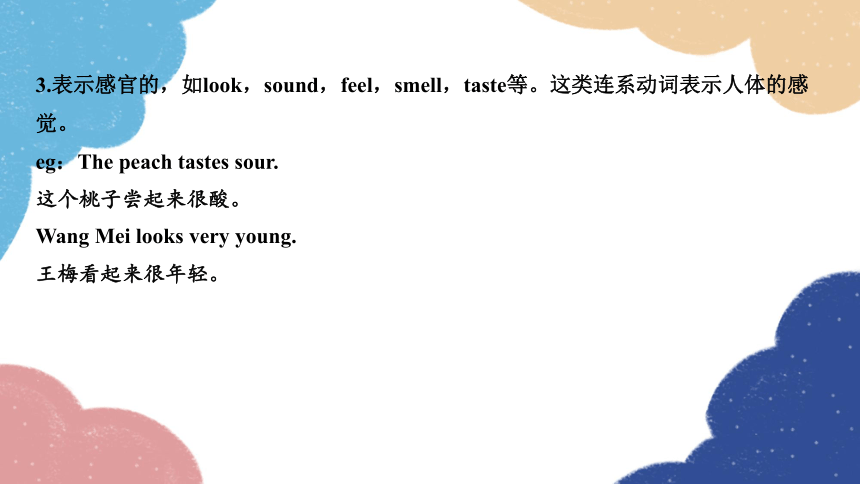
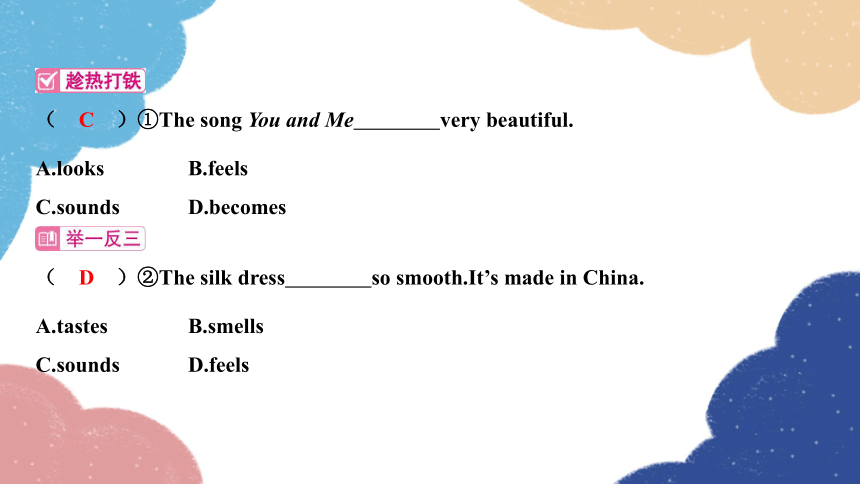
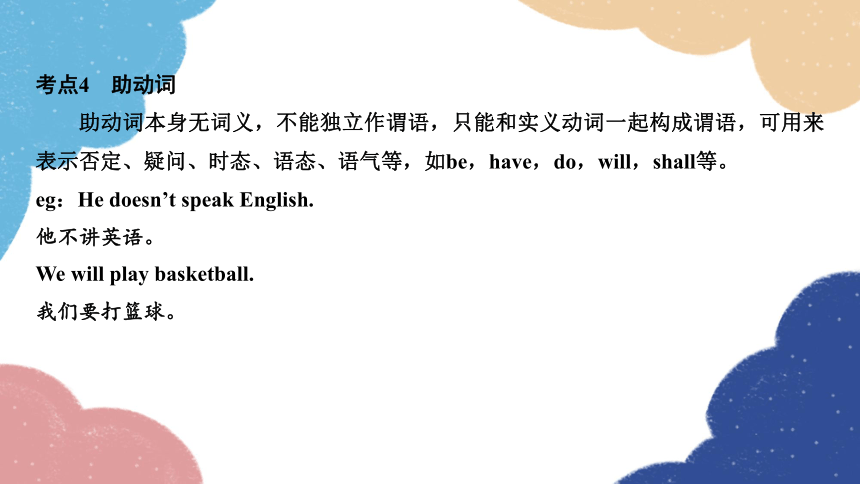
文档简介
(共65张PPT)
第八课时 动词的分类
第二章
考点突破
考点1 动词的分类
动词是一个句子的重心,每个完整的句子都必须有一个动词来作谓语,用来说明主语“是什么”或“做什么”。需要注意的是助动词和情态动词不能独立作谓语。动词分为四大类:实义动词、连系动词、助动词和情态动词。
考点2 实义动词
表示动作或状态,有完整的词义,能独立作谓语。实义动词分为及物动词和不及物动词。及物动词可以直接接宾语;不及物动词不可以直接接宾语。
eg:He often helps me.他经常帮助我。
They talked for half an hour.
他们谈了半个小时。
(1)不及物动词要接宾语,必须在不及物动词后加上适当的介词。
eg:The baby is smiling at us.
那个婴儿正对着我们笑。
He died of hunger.他死于饥饿。
Please listen to the teacher carefully.
请仔细听老师讲课。
(2)有些动词后面接双宾语,直接宾语为动词直接涉及的事物,间接宾语往往指涉及的人。间接宾语有时可放到后面去,在其前加上介词to或for即可。
eg:Jim showed us his new shoes.=Jim showed his new shoes to us.
Jim给我们展示了他的新鞋。
I bought my sister some books yesterday.=
I bought some books for my sister yesterday.
我昨天给我妹妹买了一些书。
( A )①(2020·天水)He most of his time English.
A.spends;studying B.costs;studied
C.takes;to study D.pays;studies
A
( A )②—When did you Shanghai?
—Two days ago.
A.reach B.arrive C.get D.go
A
考点3 连系动词
英语中除了连系动词be以外还有一些其他常用的连系动词,如seem,appear,prove,keep,fall,weigh,continue,stand,lie,rest,come,go,turn,get,run,become,grow,look,sound,feel,taste,smell等。英语中的连系动词语意都不完整,必须加上一个表示身份、性质、特征或者状态的表语才能使句意完整。这类连系动词表达的句式称之为系表结构。根据这些连系动词的不同含义大致可分为以下三类:
1.表示静态的,如be,seem,keep,stay等。这类连系动词常表示维持或保持某种状态。
eg:He is a student.
他是一名学生。
He always keeps silent at the meeting.
他开会时总保持沉默。
2.表示动态的,如turn,get,go,come,grow,run,become等。这类连系动词表示由变化而成为某种状态。
eg:When she saw this,her face turned red.
看到这个,她脸红了。
He became mad after that.
自那之后他疯了。
3.表示感官的,如look,sound,feel,smell,taste等。这类连系动词表示人体的感觉。
eg:The peach tastes sour.
这个桃子尝起来很酸。
Wang Mei looks very young.
王梅看起来很年轻。
( C )①The song You and Me very beautiful.
A.looks B.feels
C.sounds D.becomes
( D )②The silk dress so smooth.It’s made in China.
A.tastes B.smells
C.sounds D.feels
C
D
考点4 助动词
助动词本身无词义,不能独立作谓语,只能和实义动词一起构成谓语,可用来表示否定、疑问、时态、语态、语气等,如be,have,do,will,shall等。
eg:He doesn’t speak English.
他不讲英语。
We will play basketball.
我们要打篮球。
( B )①—Excuse me,look at the sign“NO PHOTOS”.
—Sorry,I it.
A.don’t see B.didn’t see
C.haven’t seen D.won’t see
B
②Meimei has to look after her little brother on weekends.(改为一般疑问句)
Does Meimei have to look after her little brother on weekends?
Does
have
考点5 情态动词
1.情态动词的含义及用法
情态动词 含义及用法
can(can’t) 意为“能,会”,表示一种能力。
意为“可以”,多用于口语中,表示请求、允许。
could could 是can的过去式,表示过去的能力;用在疑问句中,表示委婉地请求。
may 意为“可以”,表示请求、许可。
表示祝福和愿望。
might might是may的过去式,表示请求、许可时,语气比may更委婉。
情态动词 含义及用法
must 意为“必须”,多表示主观意愿。
have to 意为“不得不”,多表示客观必要。
shall 用于主语是第一人称的疑问句中,表示询问意见。
should(shouldn’t) 意为“应该”,表示责任和义务,也可用来表示劝告或建议。
ought to
need(needn’t) 表示需要、必须,主要用于否定句和疑问句中。
had better 意为“最好”,表示建议。
eg:I can play the piano.我会弹钢琴。
Can I use your bike to the school?
我能不能用一下你的自行车去一趟学校?
He could swim when he was six.
他六岁的时候就会游泳了。
Could you take out the trash,Linda?
Linda,你能把垃圾倒一下吗?
You may come with me if you want.
如果你想来就跟我来吧。
May you be happy!
祝你幸福!
Might I open the window?
我可以打开窗户吗?
You must finish your homework first.
你必须先完成你的家庭作业。
We have to stay at home because it’s raining.
因为下着雨,所以我们不得不待在家里。
Shall we go fishing this weekend?
我们这周末可以去钓鱼吗?
We should clean the classroom every day.
我们应该每天打扫教室。
You ought to look after them patiently.你应该耐心一点地照顾他们。
You needn’t do that again.
下次你没必要那么做了。
You’d better hand in your paper on time.你最好准时递交你的论文。
( B )①—Finish drawing a horse in ten minutes,OK?
—Sorry.It in such a short time.
A.may do B.can’t be done
C.must do D.needn’t be done
B
( C )②—Listen!Someone is singing in the next room.Is it Wei Fang?
—No.It be her.She is at school now.
A.may not B.mustn’t
C.can’t D.won’t
( B )③—Could I look at your pictures?
—Yes,of course you .
A.could B.can C.will D.might
C
B
( B )④ you pass me a pen?I’d like to write down the telephone number.
A.Need B.Could C.Must D.Should
( A )⑤—May I go to the cinema now,Dad?
—No,you .You must finish your homework first.
A.mustn’t B.won’t
C.don’t D.needn’t
B
A
2.情态动词使用“五注意”
情态动词一般没有人称和数的变化,不能单独作谓语,需与后面的动词原形一起构成谓语。使用情态动词时应注意以下五点:
(1)表示“不能”的can’t与mustn’t的区别:can’t表示“不能”时,指没有能力;mustn’t 表示“不能”时,指禁止或不允许。
①The old man is so tired that he can’t (can’t/mustn’t) go much farther.
can’t
②The baby is asleep.You mustn’t (can’t/ mustn’t)make much noise.
(2)表示“必须”的must与have to的区别:must表示说话人的主观看法;have to则表示客观需要。
mustn’t
①You must (must/have to) finish the work today.
must
②My father had to (must/had to) work when he was ten years old.
(3)回答must引导的一般疑问句时,如果是否定回答,一般不用mustn’t,而要用needn’t或don’t have to。
eg:—Must we hand in our exercise books today?今天我们必须交练习册吗?
—No,you needn’t.不,你们不必。
had to
(4)need作为情态动词时,一般不用于肯定句中,仅用于否定句、疑问句和条件状语从句中。在肯定句中,它用作实义动词,有时态、人称和数的变化,后面接带to的动词不定式或名词、代词作其宾语。
eg:You needn’t come so early.
你不用来这么早。
He needs to finish it this evening.
他需要今天晚上完成它。
(5)may的相关句式:
①may表示请求或征求对方许可,意为“可以”,常常与第一人称I连用,构成“May I...?”句式,意为“我可以……吗?”。肯定回答用“Yes,you may./Yes,please.”等;否定回答用“No,you can’t./No,you mustn’t.”,不用“No,you may not.”。
eg:—May I sit here?我可以坐在这儿吗?
—Yes,please.可以。
②“May you+动词原形...”意为“祝愿你……”。
eg:May you succeed!祝你成功!
May you be happy every day!
祝你天天快乐!
考点6 非谓语动词
我们把在句子中起名词、形容词或副词作用,充当谓语之外的其他句子成分的动词称为非谓语动词。非谓语动词主要有三种形式:动词-ing形式、动词不定式、分词(现在分词和过去分词)。
1.动词-ing形式
动词-ing形式由“动词原形+-ing”构成。它既有动词的特征,又有名词的特征。
(1)动词-ing形式作主语
eg:Listening to music is my hobby.
听音乐是我的爱好。
(2)动词-ing形式作宾语
eg:Would you mind turning down your
radio alittle?
你介意把收音机音量调小一点儿吗?
(3)动词-ing形式作表语
eg:Her job is washing,cleaning and taking care of the children.
她的工作是洗刷、打扫和照顾孩子。
(4)动词-ing形式作定语
eg:a writing desk=a desk for writing
一张写字桌
①(2020·兰州一诊)Would you mind speaking (speak) slowly?I can hardly follow you.
speaking
( D )② is one of the best ways to keep healthy.
A.Do sports B.Do sport
C.Doing sport D.Doing sports
D
2.动词不定式
动词不定式由“to+动词原形”构成。这里的to是不定式标志,没有词义。不定式具有名词、形容词或副词的某些语法功能,又有动词的时态和语态的特点及作用。
(1)不定式作宾语
eg:The driver failed to see the other car in time.司机没能及时看见另一辆车。
(2)不定式作宾语补足语
eg:Father doesn’t allow us to play in the street.父亲不让我们在街上玩耍。
注意:有些动词,如make,have,get,want等可用不定式作宾补,也可用分词作宾补。现在分词表主动,也表正在进行,过去分词表被动。
(3)不定式作主语
不定式作主语,往往用it作形式主语,真正的主语(不定式)放在句子的后面。
eg:It’s so nice to hear your voice.
听到你的声音真高兴。
(4)不定式作表语
不定式可放在be动词后面作表语。
eg:My work is to clean the room every day.
我的工作是每天打扫房间。
(5)不定式作定语
不定式作定语通常要放在被修饰的词后,往往表示未发生的动作。
eg:I have a lot of work to do.
我有许多工作要做。
(6)不定式作状语
①表目的
常用结构为to do,only to do,in order to do,so as to do,so/such...as to...。
eg:He ran so fast as to catch the first bus.
他飞快地跑以便赶上第一班公共汽车。
②表结果
可以表示没有预料到的或事与愿违的结果,不定式要放在句子后面。
eg:I woke up to find my truck gone.
我醒来发现我的卡车不见了。
③表原因
eg:I’m glad to see you.见到你很高兴。
④表理由和条件
eg:It’s impolite for you to say so.
你这样说是没有礼貌的。
注意:使役动词let,have,make后及感官动词see,watch,look,notice,observe,hear,smell,feel等在主动语态中跟省略to的不定式,但在被动语态中不能省去to。
eg:I saw him dance.=He was seen to dance by me.我看见他跳舞了。
( A )①Though she often makes her little brother ,she was made by him this morning.
A.cry;tocry B.to cry;cry
C.cry;cry D.cry;crying
A
( D )②We advise parents their children at home alone in order to keep them away from danger.
A.to not leave B.not leave
C.to leave D.not to leave
D
3.分词
分词既有动词的特征,又有形容词和副词的特征。分词有现在分词和过去分词两种。现在分词有一般式和完成式,过去分词没有这种区别。
(1)分词作定语
eg:We can see the rising sun.
我们可以看到正在升起的太阳。
(2)分词作状语
分词作状语可以表示时间、原因、理由、条件、让步等,相当于一个状语从句。选择现在分词还是过去分词,关键看主句的主语。如果分词的动作是主句的主语发出的,分词就选用现在分词,反之就用过去分词。
eg:Not receiving any letter from him,I gave him a call.由于没有收到他的信,我给他打了个电话。
Used for a long time,the book looks old.
由于用了很长时间,这本书看上去很旧。
(3)分词作补语
现在分词作补语,被补充说明的宾语或主语是它的逻辑主语(即主动关系);过去分词作补语,被补充说明的宾语或主语是它的逻辑宾语(即被动关系)。
eg:I found my car missing.
我发现我的汽车不见了。
(4)分词作表语
现在分词表示主语的性质、特征;过去分词表示主语的某种状态。
eg:The situation is encouraging.
形势鼓舞人心。
( B )①It took my daughter two weeks the novels by Liu Yong.
A.read;written B.to read;written
C.reading;to write D.to read;wrote
B
( D )②—Did you let anyone the flowers?
—Yes,I had the flowers .
A.to water;water
B.to water;watered
C.water;to be watered
D.water;watered
D
考点7 动词短语
1.同一动词
(1)break短语
break off折断 break down出故障;分解
break out爆发 break up打碎;破碎
(2)come短语
come true实现 come out出版;发表
come back回来 come over过来,顺便来访
come from来自 come on 赶快;加油
come up with 提出
(3)get短语
get out出去 get in进来
get on上车 get off下车
get up起来;起床 get to到达
get dressed 穿衣服 get over克服
get ready 准备 get together相聚
get in the way of...挡住……;妨碍……
get into陷入……;养成(习惯)
get through 通过;完成;接通(电话)
get on/along with与……相处
get away from远离;摆脱
(4)go短语
go away走开 go back 回去
go by (时间)流逝 go for努力获得;支持
go off爆炸;离开 go on继续
go out出去;熄灭 go over仔细检查
go out of one’s way特地;格外努力
(5)look短语
look after照顾 look at看
look around环顾 look into 调查
look through浏览 look for寻找
look up查询;抬头看 look down向下看
look out注意,小心
look down upon/on瞧不起
look forward to盼望,期待
(6)make短语
make friends交朋友 make fun of取笑
make sure确信;确保 make up编造;化妆
make progress取得进步
make a difference对……产生影响
make up of由……组成,构成
make up one’s mind下决心
(7)put短语
put away收好,放好 put down放下;记下
put off推迟;拖延 put out扑灭
put forward 提出(建议)
put on穿上;上演;增加(体重)
put up举起;搭建;张贴
(8)take短语
take away带走
take after与……相像
take pride in以……为骄傲
take off起飞;脱掉
take out拿出
take over接管,接收
take up占用;开始从事
take place发生 take care of照顾
take part in参加 take out of取出
take exercise做运动
(9)think短语
think about考虑 think over仔细考虑
think of想起 think up想出
think out仔细考虑;解决
(10)turn短语
turn down调低;拒绝 turn up调高;出现
turn on打开 turn off关掉
turn in上交 turn into变成
turn out结果是
2.同一介词/副词
(1)about短语
argue about 争论 care about 关心;在意
hear about 听说 complain about 抱怨
learn about 学习;了解
talk about 谈论;讨论
worry about担心;忧虑
(2)at短语
knock at敲(门、窗等) laugh at 嘲笑
shout at对……大喊 point at指向
smile at对……微笑 work at从事于
(3)away短语
throw away扔掉 give away赠送
blow away吹走 run away跑掉
fly away 飞走 pass away 去世
(4)back短语
bring back 使想起;带回
call back 回电话
come/get back 回来
give back 归还;送回
look back 回头看;回忆
pay back 偿还
talk back 顶嘴
turn back往回走;翻回到
(5)down短语
break down 出故障 cut down切断;砍倒
fall down 跌倒;倒塌 lie down 躺下
die down 逐渐变弱 take down取下;记下
knock down撞倒 write down写下
pull down拆毁,摧毁 calm down冷静
slow down 减速
(6)for短语
ask for请求 call for要求;需要
care for关心 leave for离开去……
wait for等待 stand for代表;象征
pay for为……付款
prepare for为……做准备
(7)from短语
come from来自
hear from收到……的信
learn from向……学习
stay away from 远离
(8)off短语
fall off跌落 cut off切除
set off出发 show off炫耀
give off 发出 pay off 偿清(欠款)
(9)on短语
carry on坚持;继续 feed on以……为食
keep on坚持;继续 live on靠……生活
work on从事于 go on继续
depend on依靠;取决于 hold on等一下
(10)out短语
break out 爆发
bring out 使显现;使表现出
check out 查看 hand out 分发,发放
leave out 遗漏;省去 point out 指出
work out算出;解决 give out分发;公布
find out查明 set out 出发
try out试验;选拔 carry out执行
(11)up短语
cheer up振奋 cut up切碎
clean up 打扫干净 catch up赶上
dress up盛装打扮 eat up吃光
give up放弃 grow up成长
pick up捡起 set up建立
stand up起立 stay up熬夜
show up出现 wake up叫醒
agree with同意 argue with和……争论
catch up with赶上
come up with提出,想出
deal with处理 talk with 和……交谈
(12)with短语
备考演练
一、用所给词的适当形式填空
1.(2020·武威)Borrowers are expected to return (return) books on time.
2.(2020·武威)Do you mind me opening (open) the window?
3.(2020·武威)I believe you will succeed (success) in passing the English exam.
4.(2019·兰州)Henry’s uncle is planning to take (take) a trip to Dunhuang now.
5.(2018·兰州)After finishing doing (do) your homework,you can have a good rest.
6.(2022·甘肃)The teacher asked the students to circle (circle) the correct answer.
7.(2022·甘肃)There was (be) a lot of rain outside last night.
to return
opening
succeed
to take
doing
to circle
was
8.(2022·兰州一诊)Su Yiming expected to win (win) a gold medal when he was 10 years old.
9.(2022·兰州一诊)Young people enjoy ordering (order) food online nowadays.
to win
ordering
二、根据句意及首字母提示或所给汉语意思写出句中所缺的单词或短语
1.(2020·天水)The test i ncludes three parts:listening,speaking and writing.
2.(2020·天水)He f ailed the exam because he was so careless with his spelling.
3.(2020·天水)Words could not express (表达)her feelings at that moment.
4.(2022·定西二模)首先,打开搅拌机。
First, turn on the blender.
5.(2022·定西二模)每个人都应该参与到拯救地球中来。
Everyone should take part in saving the earth.
ncludes
ailed
express
turn
on
take
part
in
三、单项选择
( A )1.(2022·无锡)—Does the color red represent good things in Chinese culture?
—Yes.But writing one’s name in red is not good,and we usually it.
A.avoid B.advise
C.allow D.accept
( D )2.(2022·本溪、葫芦岛)The soup a little salty,there is no need to add more salt.
A.looks B.smells
C.sounds D.tastes
A
D
( C )3.(2018·兰州)Bob’s father can’t stand soap operas.He enjoys sports games on TV.
A.watch B.to watch
C.watching D.watched
( B )4.(2022·包头)—How can we go to the station?
—I going in my car.
A.practise B.suggest
C.invite D.introduce
C
B
( C )5.(2022·雅安)—Excuse me. I sit here?
—You’d better not.It’s the man’s seat.
A.Must B.Need
C.Could D.Should
( D )6.(2022·河池)When I meet my friends,I always try my best to be on time.
A.set out B.turn down
C.make a plan D.make an effort
C
D
( A )7.(2022·甘肃)He offered her a trip to Australia but she turned him down.
A.refused him B.looked at him
C.hated him D.invited him
( B )8.(2022·定西二模)Which of the following is RIGHT?
A.The car needs to clean.
B.The meeting will be held in the meeting room.
C.The meat went bad because the hot weather.
D.He decided to learning English well.
A
B
( A )9.(2022·宿迁)—Miss Li,can you tell me how to improve my writing skills?
—Certainly.I advise you a diary in English every day.
A.tokeep B.keeping
C.kept D.keep
( D )10.(2022·黔东南州)An old man on the side of the road was found ,and he was sent to the hospital by the bus driver and passengers immediately.
A.lies;dies B.lay;died
C.lain;dead D.lying;dying
A
D
( B )11.(2022·天津)The book be Mary’s.We can see her name on it.
A.need B.must
C.can’t D.needn’t
( C )12.(2020·重庆A卷)They hope the basketball match.
A.win B.won
C.towin D.winning
( C )13.(2020·苏州)The doctors and nurses managed the lives of patients,though they didn’t have enough medicine.
A.save B.saving
C.to save D.to saving
B
C
C
第八课时 动词的分类
第二章
考点突破
考点1 动词的分类
动词是一个句子的重心,每个完整的句子都必须有一个动词来作谓语,用来说明主语“是什么”或“做什么”。需要注意的是助动词和情态动词不能独立作谓语。动词分为四大类:实义动词、连系动词、助动词和情态动词。
考点2 实义动词
表示动作或状态,有完整的词义,能独立作谓语。实义动词分为及物动词和不及物动词。及物动词可以直接接宾语;不及物动词不可以直接接宾语。
eg:He often helps me.他经常帮助我。
They talked for half an hour.
他们谈了半个小时。
(1)不及物动词要接宾语,必须在不及物动词后加上适当的介词。
eg:The baby is smiling at us.
那个婴儿正对着我们笑。
He died of hunger.他死于饥饿。
Please listen to the teacher carefully.
请仔细听老师讲课。
(2)有些动词后面接双宾语,直接宾语为动词直接涉及的事物,间接宾语往往指涉及的人。间接宾语有时可放到后面去,在其前加上介词to或for即可。
eg:Jim showed us his new shoes.=Jim showed his new shoes to us.
Jim给我们展示了他的新鞋。
I bought my sister some books yesterday.=
I bought some books for my sister yesterday.
我昨天给我妹妹买了一些书。
( A )①(2020·天水)He most of his time English.
A.spends;studying B.costs;studied
C.takes;to study D.pays;studies
A
( A )②—When did you Shanghai?
—Two days ago.
A.reach B.arrive C.get D.go
A
考点3 连系动词
英语中除了连系动词be以外还有一些其他常用的连系动词,如seem,appear,prove,keep,fall,weigh,continue,stand,lie,rest,come,go,turn,get,run,become,grow,look,sound,feel,taste,smell等。英语中的连系动词语意都不完整,必须加上一个表示身份、性质、特征或者状态的表语才能使句意完整。这类连系动词表达的句式称之为系表结构。根据这些连系动词的不同含义大致可分为以下三类:
1.表示静态的,如be,seem,keep,stay等。这类连系动词常表示维持或保持某种状态。
eg:He is a student.
他是一名学生。
He always keeps silent at the meeting.
他开会时总保持沉默。
2.表示动态的,如turn,get,go,come,grow,run,become等。这类连系动词表示由变化而成为某种状态。
eg:When she saw this,her face turned red.
看到这个,她脸红了。
He became mad after that.
自那之后他疯了。
3.表示感官的,如look,sound,feel,smell,taste等。这类连系动词表示人体的感觉。
eg:The peach tastes sour.
这个桃子尝起来很酸。
Wang Mei looks very young.
王梅看起来很年轻。
( C )①The song You and Me very beautiful.
A.looks B.feels
C.sounds D.becomes
( D )②The silk dress so smooth.It’s made in China.
A.tastes B.smells
C.sounds D.feels
C
D
考点4 助动词
助动词本身无词义,不能独立作谓语,只能和实义动词一起构成谓语,可用来表示否定、疑问、时态、语态、语气等,如be,have,do,will,shall等。
eg:He doesn’t speak English.
他不讲英语。
We will play basketball.
我们要打篮球。
( B )①—Excuse me,look at the sign“NO PHOTOS”.
—Sorry,I it.
A.don’t see B.didn’t see
C.haven’t seen D.won’t see
B
②Meimei has to look after her little brother on weekends.(改为一般疑问句)
Does Meimei have to look after her little brother on weekends?
Does
have
考点5 情态动词
1.情态动词的含义及用法
情态动词 含义及用法
can(can’t) 意为“能,会”,表示一种能力。
意为“可以”,多用于口语中,表示请求、允许。
could could 是can的过去式,表示过去的能力;用在疑问句中,表示委婉地请求。
may 意为“可以”,表示请求、许可。
表示祝福和愿望。
might might是may的过去式,表示请求、许可时,语气比may更委婉。
情态动词 含义及用法
must 意为“必须”,多表示主观意愿。
have to 意为“不得不”,多表示客观必要。
shall 用于主语是第一人称的疑问句中,表示询问意见。
should(shouldn’t) 意为“应该”,表示责任和义务,也可用来表示劝告或建议。
ought to
need(needn’t) 表示需要、必须,主要用于否定句和疑问句中。
had better 意为“最好”,表示建议。
eg:I can play the piano.我会弹钢琴。
Can I use your bike to the school?
我能不能用一下你的自行车去一趟学校?
He could swim when he was six.
他六岁的时候就会游泳了。
Could you take out the trash,Linda?
Linda,你能把垃圾倒一下吗?
You may come with me if you want.
如果你想来就跟我来吧。
May you be happy!
祝你幸福!
Might I open the window?
我可以打开窗户吗?
You must finish your homework first.
你必须先完成你的家庭作业。
We have to stay at home because it’s raining.
因为下着雨,所以我们不得不待在家里。
Shall we go fishing this weekend?
我们这周末可以去钓鱼吗?
We should clean the classroom every day.
我们应该每天打扫教室。
You ought to look after them patiently.你应该耐心一点地照顾他们。
You needn’t do that again.
下次你没必要那么做了。
You’d better hand in your paper on time.你最好准时递交你的论文。
( B )①—Finish drawing a horse in ten minutes,OK?
—Sorry.It in such a short time.
A.may do B.can’t be done
C.must do D.needn’t be done
B
( C )②—Listen!Someone is singing in the next room.Is it Wei Fang?
—No.It be her.She is at school now.
A.may not B.mustn’t
C.can’t D.won’t
( B )③—Could I look at your pictures?
—Yes,of course you .
A.could B.can C.will D.might
C
B
( B )④ you pass me a pen?I’d like to write down the telephone number.
A.Need B.Could C.Must D.Should
( A )⑤—May I go to the cinema now,Dad?
—No,you .You must finish your homework first.
A.mustn’t B.won’t
C.don’t D.needn’t
B
A
2.情态动词使用“五注意”
情态动词一般没有人称和数的变化,不能单独作谓语,需与后面的动词原形一起构成谓语。使用情态动词时应注意以下五点:
(1)表示“不能”的can’t与mustn’t的区别:can’t表示“不能”时,指没有能力;mustn’t 表示“不能”时,指禁止或不允许。
①The old man is so tired that he can’t (can’t/mustn’t) go much farther.
can’t
②The baby is asleep.You mustn’t (can’t/ mustn’t)make much noise.
(2)表示“必须”的must与have to的区别:must表示说话人的主观看法;have to则表示客观需要。
mustn’t
①You must (must/have to) finish the work today.
must
②My father had to (must/had to) work when he was ten years old.
(3)回答must引导的一般疑问句时,如果是否定回答,一般不用mustn’t,而要用needn’t或don’t have to。
eg:—Must we hand in our exercise books today?今天我们必须交练习册吗?
—No,you needn’t.不,你们不必。
had to
(4)need作为情态动词时,一般不用于肯定句中,仅用于否定句、疑问句和条件状语从句中。在肯定句中,它用作实义动词,有时态、人称和数的变化,后面接带to的动词不定式或名词、代词作其宾语。
eg:You needn’t come so early.
你不用来这么早。
He needs to finish it this evening.
他需要今天晚上完成它。
(5)may的相关句式:
①may表示请求或征求对方许可,意为“可以”,常常与第一人称I连用,构成“May I...?”句式,意为“我可以……吗?”。肯定回答用“Yes,you may./Yes,please.”等;否定回答用“No,you can’t./No,you mustn’t.”,不用“No,you may not.”。
eg:—May I sit here?我可以坐在这儿吗?
—Yes,please.可以。
②“May you+动词原形...”意为“祝愿你……”。
eg:May you succeed!祝你成功!
May you be happy every day!
祝你天天快乐!
考点6 非谓语动词
我们把在句子中起名词、形容词或副词作用,充当谓语之外的其他句子成分的动词称为非谓语动词。非谓语动词主要有三种形式:动词-ing形式、动词不定式、分词(现在分词和过去分词)。
1.动词-ing形式
动词-ing形式由“动词原形+-ing”构成。它既有动词的特征,又有名词的特征。
(1)动词-ing形式作主语
eg:Listening to music is my hobby.
听音乐是我的爱好。
(2)动词-ing形式作宾语
eg:Would you mind turning down your
radio alittle?
你介意把收音机音量调小一点儿吗?
(3)动词-ing形式作表语
eg:Her job is washing,cleaning and taking care of the children.
她的工作是洗刷、打扫和照顾孩子。
(4)动词-ing形式作定语
eg:a writing desk=a desk for writing
一张写字桌
①(2020·兰州一诊)Would you mind speaking (speak) slowly?I can hardly follow you.
speaking
( D )② is one of the best ways to keep healthy.
A.Do sports B.Do sport
C.Doing sport D.Doing sports
D
2.动词不定式
动词不定式由“to+动词原形”构成。这里的to是不定式标志,没有词义。不定式具有名词、形容词或副词的某些语法功能,又有动词的时态和语态的特点及作用。
(1)不定式作宾语
eg:The driver failed to see the other car in time.司机没能及时看见另一辆车。
(2)不定式作宾语补足语
eg:Father doesn’t allow us to play in the street.父亲不让我们在街上玩耍。
注意:有些动词,如make,have,get,want等可用不定式作宾补,也可用分词作宾补。现在分词表主动,也表正在进行,过去分词表被动。
(3)不定式作主语
不定式作主语,往往用it作形式主语,真正的主语(不定式)放在句子的后面。
eg:It’s so nice to hear your voice.
听到你的声音真高兴。
(4)不定式作表语
不定式可放在be动词后面作表语。
eg:My work is to clean the room every day.
我的工作是每天打扫房间。
(5)不定式作定语
不定式作定语通常要放在被修饰的词后,往往表示未发生的动作。
eg:I have a lot of work to do.
我有许多工作要做。
(6)不定式作状语
①表目的
常用结构为to do,only to do,in order to do,so as to do,so/such...as to...。
eg:He ran so fast as to catch the first bus.
他飞快地跑以便赶上第一班公共汽车。
②表结果
可以表示没有预料到的或事与愿违的结果,不定式要放在句子后面。
eg:I woke up to find my truck gone.
我醒来发现我的卡车不见了。
③表原因
eg:I’m glad to see you.见到你很高兴。
④表理由和条件
eg:It’s impolite for you to say so.
你这样说是没有礼貌的。
注意:使役动词let,have,make后及感官动词see,watch,look,notice,observe,hear,smell,feel等在主动语态中跟省略to的不定式,但在被动语态中不能省去to。
eg:I saw him dance.=He was seen to dance by me.我看见他跳舞了。
( A )①Though she often makes her little brother ,she was made by him this morning.
A.cry;tocry B.to cry;cry
C.cry;cry D.cry;crying
A
( D )②We advise parents their children at home alone in order to keep them away from danger.
A.to not leave B.not leave
C.to leave D.not to leave
D
3.分词
分词既有动词的特征,又有形容词和副词的特征。分词有现在分词和过去分词两种。现在分词有一般式和完成式,过去分词没有这种区别。
(1)分词作定语
eg:We can see the rising sun.
我们可以看到正在升起的太阳。
(2)分词作状语
分词作状语可以表示时间、原因、理由、条件、让步等,相当于一个状语从句。选择现在分词还是过去分词,关键看主句的主语。如果分词的动作是主句的主语发出的,分词就选用现在分词,反之就用过去分词。
eg:Not receiving any letter from him,I gave him a call.由于没有收到他的信,我给他打了个电话。
Used for a long time,the book looks old.
由于用了很长时间,这本书看上去很旧。
(3)分词作补语
现在分词作补语,被补充说明的宾语或主语是它的逻辑主语(即主动关系);过去分词作补语,被补充说明的宾语或主语是它的逻辑宾语(即被动关系)。
eg:I found my car missing.
我发现我的汽车不见了。
(4)分词作表语
现在分词表示主语的性质、特征;过去分词表示主语的某种状态。
eg:The situation is encouraging.
形势鼓舞人心。
( B )①It took my daughter two weeks the novels by Liu Yong.
A.read;written B.to read;written
C.reading;to write D.to read;wrote
B
( D )②—Did you let anyone the flowers?
—Yes,I had the flowers .
A.to water;water
B.to water;watered
C.water;to be watered
D.water;watered
D
考点7 动词短语
1.同一动词
(1)break短语
break off折断 break down出故障;分解
break out爆发 break up打碎;破碎
(2)come短语
come true实现 come out出版;发表
come back回来 come over过来,顺便来访
come from来自 come on 赶快;加油
come up with 提出
(3)get短语
get out出去 get in进来
get on上车 get off下车
get up起来;起床 get to到达
get dressed 穿衣服 get over克服
get ready 准备 get together相聚
get in the way of...挡住……;妨碍……
get into陷入……;养成(习惯)
get through 通过;完成;接通(电话)
get on/along with与……相处
get away from远离;摆脱
(4)go短语
go away走开 go back 回去
go by (时间)流逝 go for努力获得;支持
go off爆炸;离开 go on继续
go out出去;熄灭 go over仔细检查
go out of one’s way特地;格外努力
(5)look短语
look after照顾 look at看
look around环顾 look into 调查
look through浏览 look for寻找
look up查询;抬头看 look down向下看
look out注意,小心
look down upon/on瞧不起
look forward to盼望,期待
(6)make短语
make friends交朋友 make fun of取笑
make sure确信;确保 make up编造;化妆
make progress取得进步
make a difference对……产生影响
make up of由……组成,构成
make up one’s mind下决心
(7)put短语
put away收好,放好 put down放下;记下
put off推迟;拖延 put out扑灭
put forward 提出(建议)
put on穿上;上演;增加(体重)
put up举起;搭建;张贴
(8)take短语
take away带走
take after与……相像
take pride in以……为骄傲
take off起飞;脱掉
take out拿出
take over接管,接收
take up占用;开始从事
take place发生 take care of照顾
take part in参加 take out of取出
take exercise做运动
(9)think短语
think about考虑 think over仔细考虑
think of想起 think up想出
think out仔细考虑;解决
(10)turn短语
turn down调低;拒绝 turn up调高;出现
turn on打开 turn off关掉
turn in上交 turn into变成
turn out结果是
2.同一介词/副词
(1)about短语
argue about 争论 care about 关心;在意
hear about 听说 complain about 抱怨
learn about 学习;了解
talk about 谈论;讨论
worry about担心;忧虑
(2)at短语
knock at敲(门、窗等) laugh at 嘲笑
shout at对……大喊 point at指向
smile at对……微笑 work at从事于
(3)away短语
throw away扔掉 give away赠送
blow away吹走 run away跑掉
fly away 飞走 pass away 去世
(4)back短语
bring back 使想起;带回
call back 回电话
come/get back 回来
give back 归还;送回
look back 回头看;回忆
pay back 偿还
talk back 顶嘴
turn back往回走;翻回到
(5)down短语
break down 出故障 cut down切断;砍倒
fall down 跌倒;倒塌 lie down 躺下
die down 逐渐变弱 take down取下;记下
knock down撞倒 write down写下
pull down拆毁,摧毁 calm down冷静
slow down 减速
(6)for短语
ask for请求 call for要求;需要
care for关心 leave for离开去……
wait for等待 stand for代表;象征
pay for为……付款
prepare for为……做准备
(7)from短语
come from来自
hear from收到……的信
learn from向……学习
stay away from 远离
(8)off短语
fall off跌落 cut off切除
set off出发 show off炫耀
give off 发出 pay off 偿清(欠款)
(9)on短语
carry on坚持;继续 feed on以……为食
keep on坚持;继续 live on靠……生活
work on从事于 go on继续
depend on依靠;取决于 hold on等一下
(10)out短语
break out 爆发
bring out 使显现;使表现出
check out 查看 hand out 分发,发放
leave out 遗漏;省去 point out 指出
work out算出;解决 give out分发;公布
find out查明 set out 出发
try out试验;选拔 carry out执行
(11)up短语
cheer up振奋 cut up切碎
clean up 打扫干净 catch up赶上
dress up盛装打扮 eat up吃光
give up放弃 grow up成长
pick up捡起 set up建立
stand up起立 stay up熬夜
show up出现 wake up叫醒
agree with同意 argue with和……争论
catch up with赶上
come up with提出,想出
deal with处理 talk with 和……交谈
(12)with短语
备考演练
一、用所给词的适当形式填空
1.(2020·武威)Borrowers are expected to return (return) books on time.
2.(2020·武威)Do you mind me opening (open) the window?
3.(2020·武威)I believe you will succeed (success) in passing the English exam.
4.(2019·兰州)Henry’s uncle is planning to take (take) a trip to Dunhuang now.
5.(2018·兰州)After finishing doing (do) your homework,you can have a good rest.
6.(2022·甘肃)The teacher asked the students to circle (circle) the correct answer.
7.(2022·甘肃)There was (be) a lot of rain outside last night.
to return
opening
succeed
to take
doing
to circle
was
8.(2022·兰州一诊)Su Yiming expected to win (win) a gold medal when he was 10 years old.
9.(2022·兰州一诊)Young people enjoy ordering (order) food online nowadays.
to win
ordering
二、根据句意及首字母提示或所给汉语意思写出句中所缺的单词或短语
1.(2020·天水)The test i ncludes three parts:listening,speaking and writing.
2.(2020·天水)He f ailed the exam because he was so careless with his spelling.
3.(2020·天水)Words could not express (表达)her feelings at that moment.
4.(2022·定西二模)首先,打开搅拌机。
First, turn on the blender.
5.(2022·定西二模)每个人都应该参与到拯救地球中来。
Everyone should take part in saving the earth.
ncludes
ailed
express
turn
on
take
part
in
三、单项选择
( A )1.(2022·无锡)—Does the color red represent good things in Chinese culture?
—Yes.But writing one’s name in red is not good,and we usually it.
A.avoid B.advise
C.allow D.accept
( D )2.(2022·本溪、葫芦岛)The soup a little salty,there is no need to add more salt.
A.looks B.smells
C.sounds D.tastes
A
D
( C )3.(2018·兰州)Bob’s father can’t stand soap operas.He enjoys sports games on TV.
A.watch B.to watch
C.watching D.watched
( B )4.(2022·包头)—How can we go to the station?
—I going in my car.
A.practise B.suggest
C.invite D.introduce
C
B
( C )5.(2022·雅安)—Excuse me. I sit here?
—You’d better not.It’s the man’s seat.
A.Must B.Need
C.Could D.Should
( D )6.(2022·河池)When I meet my friends,I always try my best to be on time.
A.set out B.turn down
C.make a plan D.make an effort
C
D
( A )7.(2022·甘肃)He offered her a trip to Australia but she turned him down.
A.refused him B.looked at him
C.hated him D.invited him
( B )8.(2022·定西二模)Which of the following is RIGHT?
A.The car needs to clean.
B.The meeting will be held in the meeting room.
C.The meat went bad because the hot weather.
D.He decided to learning English well.
A
B
( A )9.(2022·宿迁)—Miss Li,can you tell me how to improve my writing skills?
—Certainly.I advise you a diary in English every day.
A.tokeep B.keeping
C.kept D.keep
( D )10.(2022·黔东南州)An old man on the side of the road was found ,and he was sent to the hospital by the bus driver and passengers immediately.
A.lies;dies B.lay;died
C.lain;dead D.lying;dying
A
D
( B )11.(2022·天津)The book be Mary’s.We can see her name on it.
A.need B.must
C.can’t D.needn’t
( C )12.(2020·重庆A卷)They hope the basketball match.
A.win B.won
C.towin D.winning
( C )13.(2020·苏州)The doctors and nurses managed the lives of patients,though they didn’t have enough medicine.
A.save B.saving
C.to save D.to saving
B
C
C
同课章节目录
- 词法
- 名词
- 动词和动词短语
- 动词语态
- 动词时态
- 助动词和情态动词
- 非谓语动词
- 冠词
- 代词
- 数词和量词
- 形容词副词及其比较等级
- 介词和介词短语
- 连词和感叹词
- 构词法
- 相似、相近词比较
- 句法
- 陈述句
- 一般疑问句和否定疑问句
- 特殊疑问句及选择疑问句
- 反意疑问句
- 存在句(There be句型)
- 宾语从句
- 定语从句
- 状语从句
- 主谓一致问题
- 简单句
- 并列句
- 复合句
- 主谓一致
- 主、表语从句
- 名词性从句
- 直接引语和间接引语
- 虚拟语气
- 感叹句
- 强调句
- 倒装句
- 祈使句
- 句子的成分
- 句子的分类
- 题型专区
- 单项选择部分
- 易错题
- 完形填空
- 阅读理解
- 词汇练习
- 听说训练
- 句型转换
- 补全对话
- 短文改错
- 翻译
- 书面表达
- 任务型阅读
- 语法填空
- 其他资料
